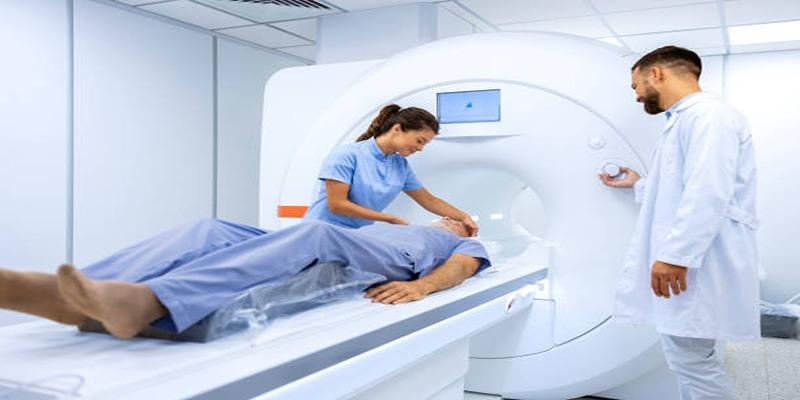When to Consider an Imaging Test for Headaches
Advertisement
Headaches are a prevalent condition, but it is sometimes difficult to know when they require further testing. Imaging tests such as MRIs or CT scans are not always necessary, but in some situations, they can be used to detect severe underlying conditions. This article will discuss when imaging tests are indicated and what symptoms require medical care.
Types of Imaging Tests:
There are a number of imaging modalities, each with specific uses and benefits in the diagnosis of particular conditions.
CT Scan
A computed tomography scan, commonly referred to as a CT scan, employs X-rays to produce precise cross-sectional images of the brain. It is especially beneficial in identifying acute conditions such as bleeding, fractures, or severe structural irregularities. The test is used routinely when a patient has symptoms such as sudden, severe headache, head injury, or neurological change such as weakness or confusion. The rapid imaging capability makes CT scans valuable in emergencies, enabling physicians to make early decisions regarding further treatment or intervention.
MRI

Magnetic Resonance Imaging (MRI) employs strong magnets and radio waves to create highly detailed images of the brain and soft tissues. The technique is particularly useful in detecting conditions such as tumors, inflammation, or blood vessel abnormalities.
MRI is frequently suggested in cases of chronic or progressively worsening headaches, and when secondary symptoms such as visual disturbances or seizures arise. While more time-consuming and costly than a CT scan, MRI is non-invasive and does not subject patients to radiation, which is why it is a tool of choice for so many diagnostic applications.
Other Less Common Imaging Methods
Apart from CT scans and MRIs, other imaging techniques may be utilized in specific cases. For example, angiography is used to visualize blood vessels and detect abnormalities like aneurysms or vascular malformations. PET scans can help identify metabolic and functional changes in the brain that may contribute to headaches.
Additionally, ultrasound may be employed in younger patients to examine certain cranial abnormalities. These less common methods are typically reserved for unique or highly specialized diagnostic needs, ensuring accurate evaluation when conventional imaging falls short.
Red Flags Indicating the Need for Imaging:
Patients presenting with certain red flags require immediate imaging to rule out serious underlying conditions. Below are critical situations and their potential implications:
Sudden Onset of Severe Headache
A thunderclap headache refers to an abrupt, severe headache that peaks in intensity within seconds to minutes. This type of headache is a medical emergency as it could indicate life-threatening conditions such as a subarachnoid hemorrhage or intracranial aneurysm rupture. Imaging, often a CT scan, is crucial to determine the cause and guide treatment promptly.
Neurological Symptoms
Headaches accompanied by neurological deficits like muscle weakness, sensory changes, or visual disturbances may suggest an underlying stroke, brain tumor, or inflammatory condition. Immediate imaging, such as MRI or CT, is essential for identifying structural abnormalities or acute events affecting the nervous system, ensuring timely intervention.
Headaches Associated with Fever etc.
When a headache occurs with symptoms such as fever, neck stiffness, or confusion, it raises concerns for infections like meningitis or encephalitis. Brain imaging, along with lumbar puncture, is critical for diagnosing and managing these potentially life-threatening conditions quickly and effectively.
History of Head Trauma
Headaches following head injuries may indicate structural damage, internal bleeding, or swelling within the brain. Imaging, typically via CT, is crucial to evaluate the extent of the damage and identify any conditions requiring emergency care, such as a hematoma or skull fracture. Prompt diagnosis ensures proper treatment and prevents complications.
Headache Types That Rarely Require Imaging:
Headache types that rarely require imaging are often diagnosed based on clinical history and presenting symptoms. Below are examples of such headaches:
Tension Headaches

Tension headaches are among the most common types of headaches and typically present as a dull, band-like pain around the forehead or the back of the head and neck. Stress, fatigue, or poor posture can trigger these headaches.
Diagnosis is straightforward and relies on clinical history rather than imaging, as there are no underlying structural concerns. Simple treatments, including over-the-counter analgesics, stress management, and stretching exercises, often provide effective relief.
Migraines Without Neurological Symptoms
Migraines without neurological symptoms, also called common migraines, involve intense, throbbing pain often accompanied by nausea or sensitivity to light and sound. However, these migraines lack aura or other neurological deficits, making imaging unnecessary when the clinical history is unremarkable.
Lifestyle modifications, migraine-specific medications, and identifying triggers like certain foods or stress can help in managing these episodes. Consistent patterns in occurrence further confirm the diagnosis without requiring advanced diagnostic procedures.
Chronic Migraine
Chronic migraines or cluster headaches with well-documented clinical histories rarely require imaging unless there is a sudden change in frequency or severity. Chronic migraines are characterized by headache episodes occurring 15 or more days per month, while cluster headaches are intensely painful, unilateral headaches often focused around one eye.
Both conditions have distinct patterns that are recognizable through clinical reports. Preventive treatments, such as prophylactic medications, and awareness of triggers are key to effective management.
Role of Medical History and Physical Examination:
In addition to imaging, a thorough medical history and physical examination are crucial in diagnosing headaches. The patient's report of symptoms, including frequency, duration, location, severity, associated features, and any medications or treatments attempted, helps direct evaluation.
A comprehensive neurological exam may reveal focal deficits, indicative of underlying conditions requiring imaging. Additionally, certain risk factors like family history or previous head trauma can guide the choice and interpretation of imaging studies.
Risks and Limitations of Imaging:
While imaging can be valuable, it is essential to consider its potential drawbacks. Several factors highlight the risks and limitations associated with imaging.
Radiation Exposure (CT Scans)
CT scans involve exposure to ionizing radiation, which, when used excessively, may increase the risk of long-term health issues such as cancer. Patients should be informed about this risk, especially if multiple scans are required or if they belong to a vulnerable group like children. Alternatives such as MRI, which do not use radiation, may be preferable in certain scenarios.
Cost Implications
The financial burden of imaging studies can be significant for patients and healthcare systems. CT scans and MRIs often come with high costs, which may not always be justified. Overuse of imaging can strain healthcare resources and lead to unnecessary expenses. Ensuring that imaging is appropriately indicated can help optimize costs while maintaining effective care.
Overuse and False Positives
Overuse of imaging in headache diagnosis can lead to the identification of incidental findings, which may not be clinically relevant. Such false positives can cause anxiety and prompt unwarranted further testing or procedures. Judicious use of imaging, guided by clinical evaluation, minimizes the risk of overdiagnosis and ensures a more targeted approach to treatment.
Conclusion:
Imaging techniques like CT scans and MRIs are essential for diagnosing headaches, but their use must be justified to balance benefits, risks, and costs. Overuse can lead to false positives, unnecessary anxiety, and financial strain on patients and healthcare systems. By following clinical evaluations and evidence-based guidelines, providers can ensure imaging is used only when necessary.
On this page
Types of Imaging Tests: CT Scan MRI Other Less Common Imaging Methods Red Flags Indicating the Need for Imaging: Sudden Onset of Severe Headache Neurological Symptoms Headaches Associated with Fever etc. History of Head Trauma Headache Types That Rarely Require Imaging: Tension Headaches Migraines Without Neurological Symptoms Chronic Migraine Role of Medical History and Physical Examination: Risks and Limitations of Imaging: Radiation Exposure (CT Scans) Cost Implications Overuse and False Positives Conclusion:Advertisement












